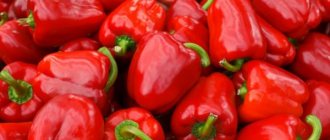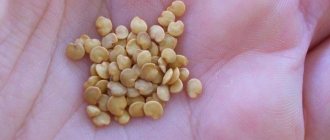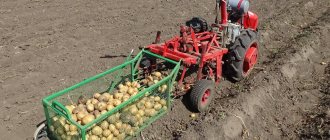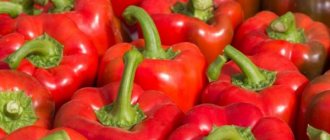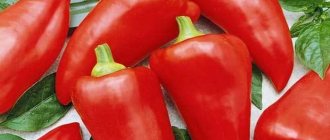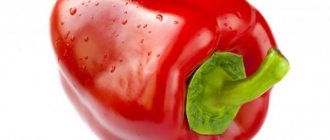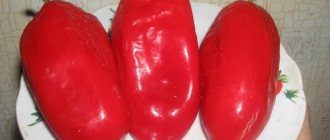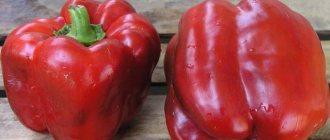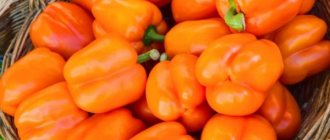Description
The pepper variety is mid-season, the fruits ripen 110 days after planting. The bush is compact, with dense foliage in which the ovaries are hidden. Plant height is 80-85 cm. The leaves are light green, slightly wrinkled.
Related article:
Take into account the whims - you will receive a harvest! Pepper Growing Tips
Unripe fruits of the vegetable have a greenish tint. Gradually they become bright orange. The weight of one copy is about 300 g, the length is 10 cm. The pepper has thick walls, the thickness of which is 10 mm. Inside the fruit, 3-4 chambers are formed in which milky-white seeds ripen. Pepper has a characteristic aroma and sweetish taste. The pulp is tender but dense, making the vegetable easily transportable.
Harvesting and uses of the crop
As in other cases, the fruits of the Siberian Bonus variety are harvested at the stage of full biological maturity, when all the peppers acquire a bright orange color. During harvesting, each fruit must be cut from the bush with a sharp knife and placed in wooden or plastic boxes that will prevent the pepper from receiving mechanical damage or completely cracking. In the future, the harvested crop can be used both fresh and for preservation, combining with other vegetables.
The Siberian Bonus pepper variety is really a good option for planting in open areas or under film cover, because regardless of the region, this crop always produces a stable, and most importantly, high-quality harvest of meaty peppers.
Main characteristics
Siberian bonus has a number of distinctive features that characterize it as a unique variety:
- The bush is low, does not take up much space and does not require tying up.
- Looks beautiful on the site thanks to its bright orange fruits. Summer residents compare it to dwarf oranges.
- Does not contain capsaicin (an alkaloid present in hot peppers), but retains the pungency and aroma characteristic of this vegetable.
- Elastic, easily transported.
- Susceptible to diseases, therefore requires regular treatment with chemicals.
- For cultivation, the seedling method is used. If you plant seeds in open ground, they will sprout late and the pepper may not ripen.
- Harvesting takes place in August-September.
- Requires regular watering, like many pepper crops.
Related article:
Pepper Lesya - description of an early ripening variety, characteristics and reviews
Due to these characteristics, the variety is very common in the northern regions of the country.
Reviews
Farmers speak positively about Siberian Bonus pepper. They note bright, tasty fruits and excellent productivity:
Elya, Oktyabrsky: “I planted Siberian Bonus peppers for the first time. A friend gave me the seeds. Despite the rainy summer, the bushes bore a decent amount of heavy fruits, bright orange, just like in the photo.”
Svetlana, Moscow: “I grew the Siberian bonus under film cover. I really liked the variety. The bushes grew up to 50 cm in height, and at the end of June thick, neat peppers formed. One fruit weighed 230 g. The vegetables pleased us with their excellent taste and light pepperiness.”
Diseases and pests
Siberian bonus is more susceptible to diseases than hybrid varieties of peppers. Sometimes it is affected by gray or white rot, black leg, and Alternaria. To combat diseases, cuproxate, copper dioxide or Bordeaux mixture are used. If the bush cannot be saved, it is removed and burned.
Related article:
Secrets of a huge pepper harvest
The most dangerous pests are aphids, slugs, whiteflies and mole crickets. The latter destroy the roots of the plant. To get rid of mole crickets, each bush is protected with a plastic bottle, digging it 10-15 cm deep. You can soak the peas in a solution of beer and any insecticide for 2 days, then scatter the bait along the pepper beds. Crawling to the surface and eating peas, mole crickets die.
To combat aphids, slugs or other insects, use insecticides according to the instructions or prepare a solution of wood ash (2 tablespoons per bucket of water). Treatment is carried out at least 2-3 times per season.
Advantages and disadvantages
The advantages of the Siberian bonus include:
- high yield (up to 7 kg per 1 sq. m);
- bright characteristic aroma;
- juicy pulp, in which bitterness is almost not felt;
- unpretentiousness;
- compactness of the bush;
- can be grown in cold regions;
- ripening of fruits after harvest;
- versatility of application.
Related article:
What is the best way to grow pepper seedlings at home?
Disadvantages include susceptibility to diseases and pests and the need for frequent chemical treatment.
Caring for the plant after transplanting into the ground
After transplanting pepper seedlings into open soil, caring for the plants does not stop, but on the contrary, it must be done with even greater diligence.
To get a good harvest, it is not enough to plant the plants in a well-lit, sunny area; it is also important to organize watering correctly and timely hill up and loosen the soil under the bushes. Each of these actions has its own characteristics, which should never be forgotten.
Watering and fertilizing
The Siberian Bonus pepper variety is favorable to watering, but this does not mean that the plants need to be watered. Before adding the next portion of liquid, always evaluate the condition of the top soil layer, which should dry out at least 2–3 cm deep.
Planting and care
Peppers are grown in seedlings. Young seedlings dive before rooting in the ground, but you can do without this procedure. Before planting, the seeds are sorted. If they were collected from your own plot, and not bought in a specialized store, you need to prepare a solution of 30-40 g of table salt and 1 liter of water. Seeds are poured into the salty liquid. After 5-7 minutes, empty specimens will float to the surface of the water. They are removed, and healthy ones are dried on paper.
Important! When to fertilize pepper seedlings
Then the seeds are soaked in a 1% solution of potassium permanganate for disinfection and in nitrophoska for half an hour (1 teaspoon of fertilizer per 1 liter of water). For planting, prepare a soil mixture consisting of 2 parts humus and 1 part turf soil. You can mix humus half and half with peat. Be sure to add 3 tbsp to the substrate. l. dolomite flour or 1-2 tbsp. l. chalk per 10 cubic meters m. If seeds are planted in the ground from the site, it is first scalded with boiling water to kill parasites and fungal spores.
Related article:
How to pick bell peppers correctly
The container for growing seedlings can be small cups, boxes or peat bags. The seeds are deepened into the soil 1 cm and sprinkled with water from a spray bottle. The container is covered with polyethylene and left on the windowsill at a temperature of +26… +28 degrees.
The seeds are sown a couple of months before the seedlings take root in the ground. In the northern regions, this period occurs at the end of March - beginning of April. In the southern regions it can be planted at the end of winter.
Picking is carried out after the first two leaves appear. Each plant is given its own container and shaded from sunlight during the first week. You can water 6 days after picking with settled filtered water in the morning. After a couple of weeks, you can feed the plant with sodium humate or special fertilizers for vegetables. Subsequently, the culture is fed after 10 days.
Related article:
How to grow pepper seedlings from seeds at home, step-by-step instructions
If seedlings are grown without picking, you should pay attention to a number of features:
- the polyethylene is opened slightly 2 days after the sprouts appear, then removed altogether;
- Daylight hours are extended with the help of phytolamps;
- after 4 leaves appear, the pepper is transplanted into a large container with a lump of earth and sprayed with honey water;
- after a couple of weeks, the culture is watered with the settled liquid;
- after 3 weeks you can fertilize with organic compounds or ash.
Pots with plants need to be turned on different sides towards the light so that the stem grows evenly and does not bend. When spring frosts pass (late April - early May), the seedlings are transferred to open ground. The distance between bushes should be 60-70 cm, i.e. per 1 sq. m there are no more than 4-5 copies.
Related article:
Sweet pepper Atlant F1: description and reviews
Water the transplanted bushes moderately in the morning and evening with settled warm water. After watering, the soil is loosened to a depth of 3-4 cm, slightly hilling the bushes to stimulate the formation of additional roots.
As they grow, the bushes pinch the shoots. The cut areas are sprinkled with ash. To prevent the plant from breaking under the weight of the fruit, it can be tied to a peg.
It will not be superfluous to feed the plant. A couple of weeks after planting, the plantings are watered with a 1:15 solution of mullein. You can also use compounds with nitrogen: saltpeter, nitrophoska. Before flowering, be sure to feed with bio-infusions of nettles or weeds. During fruiting, use Potassium or other potassium preparations.
The best varieties of pepper for open ground
This section is devoted to peppers of Siberian selection, which can be grown in open-air garden beds. Although it should be noted that yields under shelters will still be higher, especially if the climate is cold and it is difficult to predict what vagaries the weather will bring in the summer.
Firstborn of Siberia
One of the most productive peppers of Siberian selection is the mid-season variety Pervenets Siberia. Small peppers form on a compact bush up to 30-45 cm high. Their shape is pyramidal, weighing on average up to 70 grams. The skin is glossy, first yellowish and then red. Pericarp – 7-10 mm.
This variety is distinguished by stable (up to 10-12 kg per square meter) yield, resistance to many diseases, and high commercial quality of the fruit. Lightweight variety and suitable for transportation.
Peppers are used for preservation and preparation of various dishes.
Dandy
Breeders developed an early variety of pepper called Shchegol for growing in garden beds. On low spreading bushes, beautiful cylindrical fruits weighing up to 120-130 grams ripen.
They are used in salads, for lecho, preservation, and above all, the variety is valued for the thick walls of the peppers (up to 10 mm). Another plus is Shchegol’s unpretentiousness, its resistance to temperature changes, and its stable yield.
The color of the fruits is first green, then, in the phase of biological ripeness, they become bright yellow. Productivity – more than 3.8 kg per square meter. meters.
Moneybags
A tiny variety that will delight you with fruits weighing up to 200 grams. Of the varieties of Siberian selection, this variety is considered one of the thickest-walled, the pericarp is 10-12 mm.
The bush is low, up to 45-50 cm, early in terms of ripening. The fruits are prismatic, with slight ribbing, slightly flattened. When fully ripe, the skin is bright red in color.
Features of the Tolstosum variety: unpretentiousness, compactness, increased content of vitamin C in the fruits.
Merchant
The Kupets variety will also produce a good harvest when grown directly in the garden beds. This is an early pepper that produces fruits weighing up to 90-100 grams. The peppers are thick-walled, up to 7 mm, tasty and very aromatic. They have a pyramidal shape, which makes them suitable for any type of preservation and stuffing.
The bush itself is up to 90 cm, semi-spreading, and tolerates cold weather well. It is recommended to cover plants in beds with non-woven materials.
Apple saved
This variety of pepper is inferior to many in terms of bush height; it grows only up to 45 cm. But this does not prevent it from forming large and sweet peppers weighing up to 200-300 grams. The Apple variety saved well because it combines early ripening, plant compactness and large fruit.
It is for these qualities that he receives special attention from gardeners. The fruits are cube-shaped, initially dark green in color, then gradually turning red. The thickness of the pericarp is up to 9 mm, the flesh is very juicy and sweet. The yield of such crumbs is up to 1.5 kg per bush, while per 1 sq. You can plant up to 5 plants per meter. Ripening time is about 100 days, it is recommended for growing in beds, as well as in greenhouses and under arcs.
Novosibirsk
You will only need to wait a hundred days before harvesting the first fruits of the Novosibirsk pepper. Of course, you will have to work hard, but from one square. meter it will be possible to remove up to 10 kg of fruit.
The variety is very unpretentious, early, productive. The plant usually reaches 60-70 cm, the fruits are prism-shaped, grow in different directions, and are bright red. By weight, each pepper grows up to 120-150 grams; with good care, you can grow slightly larger peppers (up to 180 grams). Walls up to 7-8 mm thick.
The taste is very good, the aroma is present. This variety is suitable for both processing and salads.
Siberian felt boots
Cold-resistant and unpretentious are two parameters that distinguish this hybrid from a number of others. However, the Siberian felt boot is distinguished by its large fruits and excellent taste, while its peppers ripen already at 100-110 days.
The plant is up to 70 cm in height, recommended for growing in open ground (however, this variety, like others, can also be planted in shelters). The fruits are elongated, cube-shaped, weighing up to 180 grams, with red skin.
The thickness of the pericarp is 9-10 mm. The variety is suitable for salads, slicing, canning, lecho and freezing.
East market
This is a classic sweet pepper, with prism-shaped, slightly elongated red fruits and thick (up to 7-8 mm) walls.
The Eastern Bazaar variety is mid-early, bears fruit well in open ground, and has high yields (up to 4.5-5 kg/sq.m.).
It was bred by Siberian breeders, adapted for difficult climates, and is very resistant to diseases. The bush grows to about 70 cm, the fruits weigh up to 150 grams.
This pepper is used for stuffing (ideal), freezing, lecho, canning and salads.
